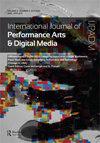化身、激进主义和后数字表现:不稳定的中间身份
IF 0.9
0 THEATER
International Journal of Performance Arts and Digital Media
Pub Date : 2023-05-04
DOI:10.1080/14794713.2023.2213018
引用次数: 1
摘要
技术。通过要求我们思考新鲜的概念(例如巴赞的“完美幻觉”),以及媒体艺术如何继续激发我们对扩展现实表达的好奇心,吴恩达在重新思考我们如何通过“后屏幕”来看待和体验世界方面的复杂性既细致又严谨。屏幕边界所在的地方将读者带入内化的后屏幕,在那里你会情不自禁地思考自己的真相。本文章由计算机程序翻译,如有差异,请以英文原文为准。
Avatars, Activism and Postdigital Performance: precarious intermedial identities
technologies. By asking us to consider notions of newness (Bazin’s ‘perfect illusion’ for example), and how media art continues to arouse our curiosity for extending expressions of reality, Ng ‘s sophistication in re-thinking how we see and experience the world through The Post-Screen is both detailed and rigorous. Where screen boundaries lie ushers the reader towards an internalised post-screen, where you can’t help but consider your own truth.
求助全文
通过发布文献求助,成功后即可免费获取论文全文。
去求助
来源期刊

International Journal of Performance Arts and Digital Media
Arts and Humanities-Visual Arts and Performing Arts
CiteScore
1.70
自引率
0.00%
发文量
29
 求助内容:
求助内容: 应助结果提醒方式:
应助结果提醒方式:


